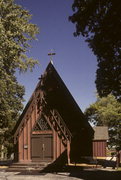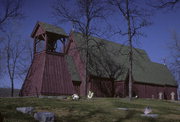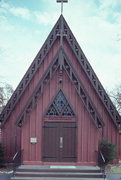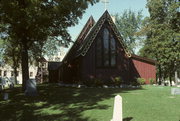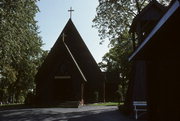Property Record
1111 GENESEE ST
Architecture and History Inventory
| Historic Name: | St. John Chrysostom Church |
|---|---|
| Other Name: | ST JOHN CHRYSOSTOM EPISCOPAL CHURCH |
| Contributing: | |
| Reference Number: | 7826 |
| Location (Address): | 1111 GENESEE ST |
|---|---|
| County: | Waukesha |
| City: | Delafield |
| Township/Village: | |
| Unincorporated Community: | |
| Town: | |
| Range: | |
| Direction: | |
| Section: | |
| Quarter Section: | |
| Quarter/Quarter Section: |
| Year Built: | 1851 |
|---|---|
| Additions: | 1853 |
| Survey Date: | 1980 |
| Historic Use: | house of worship |
| Architectural Style: | Early Gothic Revival |
| Structural System: | |
| Wall Material: | Board and Batten |
| Architect: | Richard Upjohn ? |
| Other Buildings On Site: | |
| Demolished?: | No |
| Demolished Date: |
| National/State Register Listing Name: | St. John Chrysostom Church |
|---|---|
| National Register Listing Date: | 2/23/1972 |
| State Register Listing Date: | 1/1/1989 |
| National Register Multiple Property Name: |
| Additional Information: | A 'site file' exists for this property. It contains additional information such as correspondence, newspaper clippings, or historical information. It is a public record and may be viewed in person at the Wisconsin Historical Society, State Historic Preservation Office. Humble yet dignified, simple yet ornate, St. John Chrysostom Church is an exceptional essay in Gothic Revival religious architecture. A steeply pitched gabled roof shelters the rectangular nave of this board-and-batten church. The slightly smaller but equally steep gable on the east end covers the chancel. There, delicate bargeboards, pierced with quatrefoil and diamond-tracery motifs, trim both gables, and a generous triple lancet of stained glass lights the interior. The unusual freestanding board-and-batten bell tower is original; a small gable shelters its open belfry. The board-and-batten entry vestibule on the west side dates from the 1950s. St. John’s interior is crafted almost entirely of wood. A beamed ceiling shelters the nave and its wooden pews. An oak Gothic-arched rood screen, which carpenter Alden Kelly embellished with trefoil tracery, separates the nave from the chancel. Local blacksmith Jacob Luther contributed the hand-wrought iron hinges, meant to evoke the branches of a tree, symbol of the resurrection. St. John strongly resembles a country-church design that renowned church architect Richard Upjohn published in his 1852 pattern book, Upjohn's Rural Architecture. St. John’s nave and chancel are nearly the same size and proportion as the pattern-book prototype. So is the exterior plan, except that St. John lacks a steeple. Even the woodwork inside--pulpit, lectern, and baptismal font--echoes Upjohn’s design. Consequently, some scholars have attributed the design of this building to Upjohn. But construction of this church began a full year before Upjohn published his book. Moreover, none of Upjohn’s wooden churches had tracery in their bargeboards--the detail that makes St. John Chrysostom distinctive. Church history attributes St. John’s design to Ralston Cox. The brother-in-law of the church’s missionary, Rev. William Markoe, Cox probably based his design on Upjohn’s work, either a church he had seen or one of the plans Upjohn produced for another rural congregation. |
|---|---|
| Bibliographic References: | PERRIN, HISTORIC WISCONSIN BUILDINGS, 1962. ZIMMERMAN. BUILDINGS OF WISCONSIN MANUSCRIPT. |
| Wisconsin Architecture and History Inventory, State Historic Preservation Office, Wisconsin Historical Society, Madison, Wisconsin |

